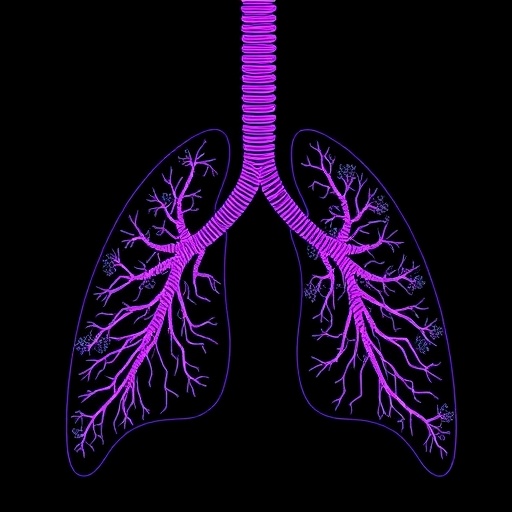In recent groundbreaking research published in the Journal of Translational Medicine, scientists have illuminated the intricate mechanisms underlying high-altitude pulmonary hypertension (HAPH), a condition that poses serious risks to individuals exposed to elevated altitudes. The study, led by a team of researchers including Guo, Zhu, and Xu, has identified a novel protein, PHPT1, that plays a critical role as an inhibitor in the progression of this complex cardiovascular disease. The implications of these findings might drastically alter how we approach the treatment and understanding of HAPH.
High-altitude pulmonary hypertension is a pathological condition characterized by elevated blood pressure in the pulmonary arteries, triggered by the reduced oxygen levels found in higher altitudes. While the body typically adapts to lower oxygen concentrations through physiological changes, some individuals experience maladaptive responses, leading to HAPH. These maladaptive responses can result in symptoms such as shortness of breath, fatigue, and even heart failure, underscoring the urgent need for effective therapeutic strategies.
At the core of this research is the protein PHPT1, which has emerged as a key player in regulating cellular responses to hypoxia, or low oxygen levels. Prior studies have hinted at the potential roles of various proteins in HAPH, but the specific mechanisms remained elusive. This new study sets a precedent by demonstrating how PHPT1 functions as an inhibitor of HAPH through its effects on TRPV5, a calcium channel known for its roles in cellular signaling pathways. By negatively regulating TRPV5, PHPT1 appears to modulate the growth of pulmonary vasculature, offering a pathway for therapeutic intervention.
The researchers embarked on a comprehensive investigation to understand the intricate relationship between PHPT1 and TRPV5. This involved a series of in vitro and in vivo experiments, leading to crucial insights into how manipulating PHPT1 levels can influence pulmonary arterial pressure. The evidence presented in this study suggests that heightened PHPT1 activity reduces TRPV5 expression, thereby alleviating the pathological remodeling of pulmonary arteries commonly seen in HAPH.
One of the most striking findings from the study was the identification of the signaling pathways intertwined with PHPT1 and TRPV5. The team utilized advanced molecular biology techniques, including CRISPR gene editing, to dissect the specific roles each molecule plays in cellular signaling. By elucidating these pathways, they painted a clearer picture of the biological responses elicited by low oxygen environments and how PHPT1 can tip the balance towards protective mechanisms.
The potential for developing targeted therapies based on these findings is monumental. As researchers look towards pharmacological interventions, the focus on PHPT1 as a therapeutic target could lead to the development of novel treatments that specifically modulate its activity. This is particularly exciting given the limited options currently available for patients suffering from HAPH. The hope is that by harnessing the inhibitory effects of PHPT1 on TRPV5, clinicians can create personalized approaches that improve patient outcomes.
Moreover, the implications of this research extend beyond understanding HAPH alone. The role of calcium channels, and particularly TRPV5, has been a point of interest in various other cardiovascular diseases. By delineating the functional relationships between PHPT1 and TRPV5, this study opens new avenues not just in research but also in the clinical setting, potentially leading to breakthroughs in managing conditions that stem from calcium signaling disruptions.
While these findings position PHPT1 as a prominent player in HAPH, it also raises further questions regarding its expression in different populations and altitudinal adaptations. Future studies will need to address how genetic variations impact PHPT1 activity and TRPV5 regulation across diverse populations, revealing crucial insights that could help in the development of universal treatment modalities.
The researchers’ next steps will likely involve clinical trials, aimed at validating their preclinical findings in human subjects. By observing how modulation of PHPT1 affects HAPH in real-world conditions, they hope to create a comprehensive treatment protocol that is not only effective but also safe for a broad patient demographic.
In summary, the study by Guo and colleagues heralds a significant advancement in our understanding of high-altitude pulmonary hypertension. By unveiling the role of PHPT1 as an inhibitory regulator through negative signaling via TRPV5, they have set a stage ripe for therapeutic innovation. As the scientific community keenly anticipates further developments, the potential for this new knowledge to transform treatment strategies for HAPH is undeniably promising.
Understanding high-altitude pulmonary hypertension requires a multifaceted approach that considers genetic factors, environmental influences, and individual physiological responses. The work of these researchers exemplifies how detailed molecular insights can inform and enhance clinical practices. As we continue to traverse into uncharted territories of genetic and environmental interactions, studies like this will remain pivotal in steering both our scientific understanding and treatment paradigms towards new horizons.
Embracing an integrative perspective will allow future research to build upon these foundational findings. As pathophysiological mechanisms become clearer, the possibility of providing targeted and effective treatments to vulnerable populations becomes increasingly tangible. With every advancement in this field, we inch closer to alleviating the burdens placed on individuals suffering from high-altitude pulmonary hypertension and chronic respiratory illnesses.
In conclusion, the study conducted by Guo, Zhu, and Xu marks a formidable leap forward in the understanding of HAPH. Their innovative exploration into the dynamics of PHPT1 and TRPV5 establishes new connections that promise to revolutionize our therapeutic approaches and ultimately save lives. As further investigations unfold, the medical community eagerly looks forward to the translation of these findings into clinical practice.
Subject of Research: High-Altitude Pulmonary Hypertension
Article Title: PHPT1 acts as an inhibitor in high-altitude pulmonary hypertension via negative TRPV5 signaling regulation
Article References:
Guo, G., Zhu, Mx., Xu, X. et al. PHPT1 acts as an inhibitor in high-altitude pulmonary hypertension via negative TRPV5 signaling regulation.J Transl Med 23, 968 (2025). https://doi.org/10.1186/s12967-025-06980-8
Image Credits: AI Generated
DOI: 10.1186/s12967-025-06980-8
Keywords: High-altitude pulmonary hypertension, PHPT1, TRPV5, signaling pathways, therapeutic targets




